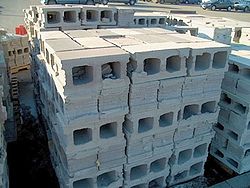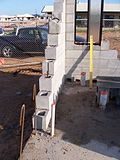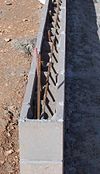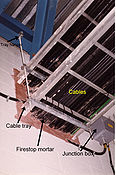- Concrete masonry unit
-
In the United States, a concrete masonry unit (CMU) – also called concrete block, cement block, and foundation block – is a large rectangular brick used in construction. Concrete blocks are made from cast concrete, i.e. Portland cement and aggregate, usually sand and fine gravel for high-density blocks. Lower density blocks may use industrial wastes as an aggregate. Those that use cinders (fly ash or bottom ash) are called cinder blocks in the US, breeze blocks (breeze is a synonym of ash)[1] in the UK and are also known as besser blocks or bricks in Australia. Clinker blocks use clinker as aggregate. In non-technical usage, the terms cinder block and breeze block are often generalized to cover all of these varieties. Lightweight blocks can also be produced using aerated concrete.
Contents
Sizes and structure
Concrete blocks may be produced with hollow centres to reduce weight or improve insulation. The use of blockwork allows structures to be built in the traditional masonry style with layers (or courses) of staggered blocks. Blocks come in many sizes. In the US, with an R-Value of 1.11 the most common nominal size is 8×8×16 in (200×200×410 mm); the actual size is usually about 3⁄8 in (9.5 mm) smaller to allow for mortar joints. In Ireland and the UK, blocks are usually 440×215×100 mm (17×8.5×3.9 in) excluding mortar joints. In New Zealand, blocks are usually 390 × 190 × 190 mm excluding mortar joints.
Uses
Concrete block, when reinforced with concrete columns and tie beams, is a very common building material for the load-bearing walls of buildings, in what is termed "concrete block structure" (CBS) construction. American suburban houses typically employ a concrete foundation and slab with a concrete block wall on the perimeter. Large buildings typically use copious amounts of concrete block; for even larger buildings, concrete block supplements steel I-beams. Tilt-wall construction, however, is replacing CBS for some large structures.
Structural properties
The compressive strength of concrete masonry units and masonry walls varies from approximately 1,000 psi (7 MPa) to 5,000 psi (34 MPa) based on the type of concrete used to manufacture the unit, stacking orientation, the type of mortar used to build the wall, reinforcement, and other factors. [2][3][4]
Gallery
This gallery shows images of 200 series (190 x 190 x 390 full blocks) modular concrete blockwork used in residential construction in a cyclonic region of Northern Australia. Typically there is a vertical reinforced (N12 [1/2" or #4 U.S.] or N16 [5/8" or #5 U.S.] rebar) concrete core at every corner, alongside each opening and at 600 mm (24 in) centers elsewhere. Bond beams (typically 2/N12 [1/2" or #4 U.S.] rebar) occur continuously around perimeter and over all openings and under windows. Corefill concrete is typically 15 MPa (2,200 psi) compressive strength. For more photos of similar construction see hurricane-proof building.
-
HVAC shaft with 2 hour fire-resistance rating under construction at DuPont Canada, Mississauga, Ontario, 1986.
-
Head-of-Wall building joint.
See also
References
- ^ "breeze, n.3". The Oxford English Dictionary (2nd ed.). Oxford University Press. 1989. http://dictionary.oed.com/cgi/entry/50027165/50027165se1. Retrieved 2007-11-30.
- ^ http://www.cement.org/pdf_files/IS276.pdf
- ^ http://www.nrc-cnrc.gc.ca/obj/irc/doc/pubs/nrcc26362/nrcc26362.pdf
- ^ http://chestofbooks.com/reference/Henley-s-20th-Century-Formulas-Recipes-Processes-Vol3/Properties-of-Concrete-Blocks-8212-Strength.html
External links
Categories:- Building materials
- Masonry
Wikimedia Foundation. 2010.









